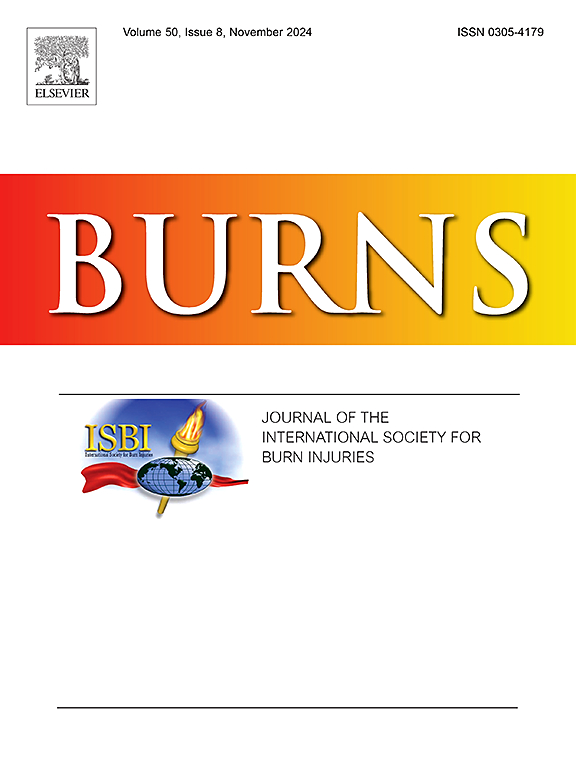植皮作为预防儿童深度烧伤感染的策略
IF 2.9
3区 医学
Q2 CRITICAL CARE MEDICINE
引用次数: 0
摘要
背景:感染性并发症是深度烧伤患者发病和死亡的重要原因,尤其是儿科患者。虽然在痂切除术后通常采用自体裂厚皮肤移植来促进伤口愈合,但其在降低感染率和减少抗生素需求方面的效果尚不清楚。目的本研究旨在评估植皮对儿科患者创面感染并发症、全身炎症反应综合征(SIRS)发展及抗生素治疗需求的影响。方法回顾性分析意大利切塞纳Bufalini医院2018 - 2024年收治的123例小儿烧伤患者。使用处理加权逆概率(IPTW)来平衡协变量。应用Cox比例风险模型评估移植对创面感染并发症发生时间、后续SIRS发展和抗生素治疗需求的影响。使用时间不敏感的逻辑模型和留一方法进行敏感性分析,以评估结果的稳健性。结果植皮可显著降低创面感染并发症发生风险(风险比= 0.12,95 % CI: 0.02 ~ 0.58, p <; 0.01)和SIRS发生风险(风险比= 0.14,95 % CI: 0.03 ~ 0.73, p = 0.02)。在抗生素治疗的需求方面也发现了一个不显著的趋势。敏感性分析证实了结果的稳健性。结论自体裂厚移植对预防小儿烧伤感染并发症具有重要作用。对于深度烧伤的儿童,早期植皮可能作为治疗方案的一部分发挥关键作用,有待于更大的多中心研究的证实。本文章由计算机程序翻译,如有差异,请以英文原文为准。
Skin grafting as a preventive strategy against infections in children with deep burns
Background
Infectious complications are a significant cause of morbidity and mortality in patients with deep burns, especially pediatric patients. While autologous split thickness skin grafting is commonly used after escharectomy to promote wound healing, its effect on reducing infection rates and the need for antibiotics in this population is not well understood.
Objective
This study aimed to evaluate the impact of skin grafting on the incidence of wound infectious complications, systemic inflammatory response syndrome (SIRS) development, and the need for antibiotic treatment, in pediatric patients.
Methods
A retrospective cohort of 123 pediatric burn patients treated at Bufalini Hospital, Cesena, Italy, between 2018 and 2024 was analyzed. Inverse probability of treatment weighting (IPTW) was used to balance covariates. Cox proportional hazards models were applied to assess the influence of grafting on the time to wound infectious complications, subsequent SIRS development, and need for antibiotic treatment. Sensitivity analysis using both time-insensitive logistic models and leave-one-out approach were performed to assess robustness of findings.
Results
Skin grafting significantly reduced the risk of wound infectious complications (hazard ratio = 0.12, 95 % CI: 0.02–0.58, p < 0.01) and SIRS development (hazard ratio = 0.14, 95 % CI: 0.03–0.73, p = 0.02). A non-significant trend was also identified in the need for antibiotic treatment. Sensitivity analysis confirmed the robustness of the results.
Conclusion
Autologous split thickness grafting plays a critical role in preventing infectious complications in pediatric burn patients. In children with deep burns, early skin grafting may play a pivotal role as part of the treatment protocol, pending confirmation from larger multi-center studies.
求助全文
通过发布文献求助,成功后即可免费获取论文全文。
去求助
来源期刊

Burns
医学-皮肤病学
CiteScore
4.50
自引率
18.50%
发文量
304
审稿时长
72 days
期刊介绍:
Burns aims to foster the exchange of information among all engaged in preventing and treating the effects of burns. The journal focuses on clinical, scientific and social aspects of these injuries and covers the prevention of the injury, the epidemiology of such injuries and all aspects of treatment including development of new techniques and technologies and verification of existing ones. Regular features include clinical and scientific papers, state of the art reviews and descriptions of burn-care in practice.
Topics covered by Burns include: the effects of smoke on man and animals, their tissues and cells; the responses to and treatment of patients and animals with chemical injuries to the skin; the biological and clinical effects of cold injuries; surgical techniques which are, or may be relevant to the treatment of burned patients during the acute or reconstructive phase following injury; well controlled laboratory studies of the effectiveness of anti-microbial agents on infection and new materials on scarring and healing; inflammatory responses to injury, effectiveness of related agents and other compounds used to modify the physiological and cellular responses to the injury; experimental studies of burns and the outcome of burn wound healing; regenerative medicine concerning the skin.
 求助内容:
求助内容: 应助结果提醒方式:
应助结果提醒方式:


